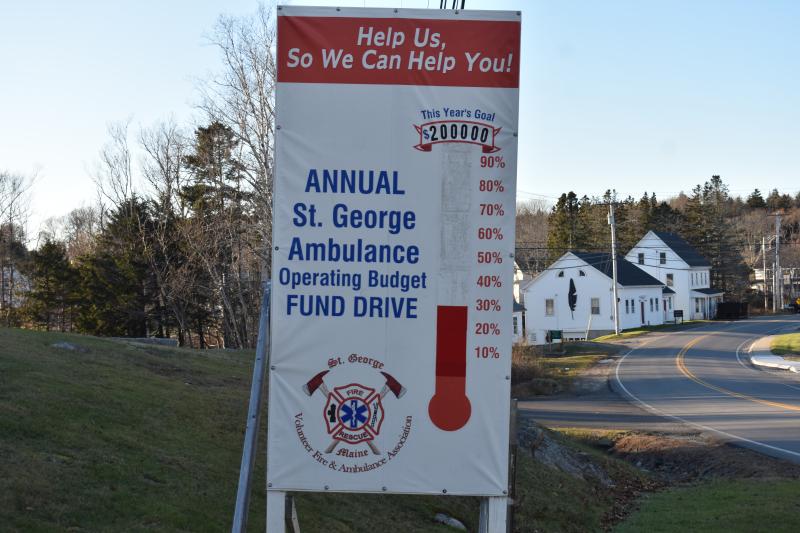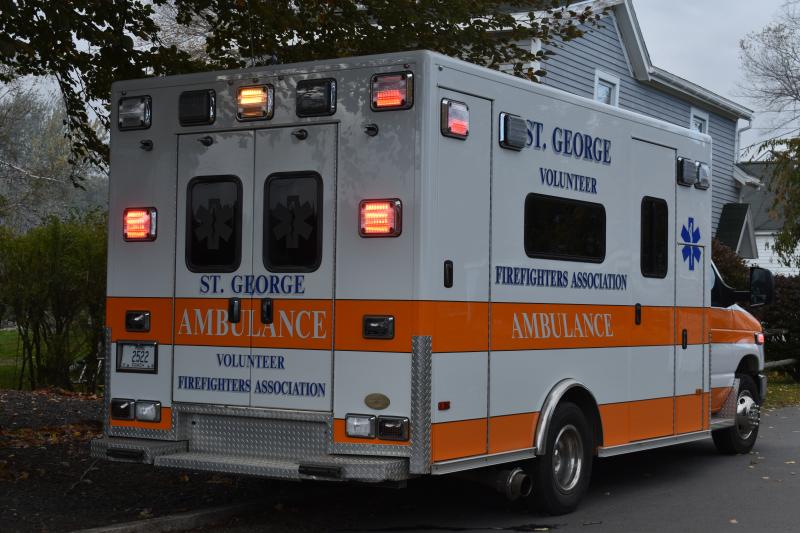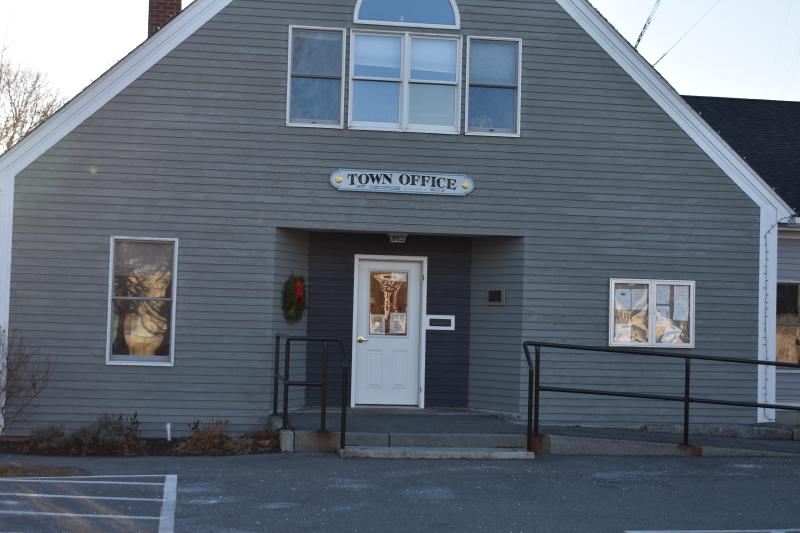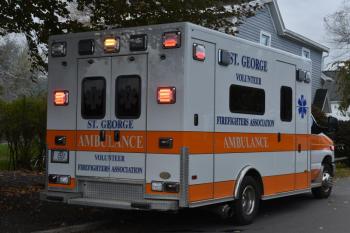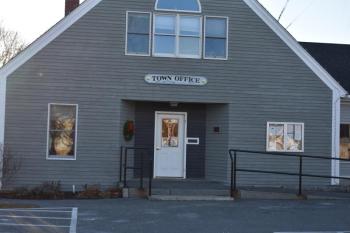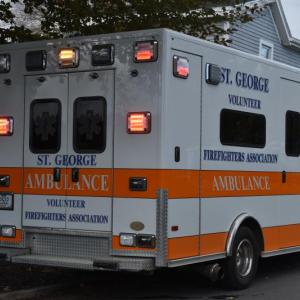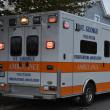Unable to sustain itself with donations, St. George nonprofit ambulance service looks to town for help
ST. GEORGE — After almost 70 years, the last nonprofit ambulance service in Knox County is no longer able to sustain itself through fundraising efforts, grants, and volunteer personnel. Now, the Town must decide whether to incorporate the emergency service into a municipal department.
In a preliminary public discussion attended by a small group of townspeople, Thursday, Dec. 1, 2022, alternative ideas in the form of “why not?” questions were floated. Yet, none of them provided a viable solution, leading the Town of St. George, and its residents, to face difficult decisions, and according to Town Manager Rick Erb, many other communities will be watching how the Town’s approach.
The St. George charter allows for the creation of new departments, provided that they are created through an ordinance. Ordinances can be adopted by the Town after holding public hearing, and then requires a referendum vote, which is a secret ballot vote.
“Inevitably, if we were going to move ahead with this, it’s going to take until, most likely, the day before the Town meeting [in May],” said Erb. “We’ve still got a ways to go until then.”
St. George EMS has been serving its community since 1953, and has been covered financially through the 503(c) St. George Volunteer Firefighters & Ambulance Association (SGVFFAA) since the name was branded in 1990. But with a very small regional labor pool to compete with and increasing expectations of financial compensation by potential applicants the service is at a breaking point.
Last year, after EMS created a payroll for full time in-house staff and began providing compensation for pager-carrying volunteers, the Town generated its own EMS budget of $230,000 to assist with finances. However, the increase in operational costs, and fundraising donations falling short, the ambulance is now opting to further dissolve its independence in order to benefit from shared Town resources.
Despite the financial pinch, Select Board Chair Richard Bates said, “this is absolutely the best decision for the Town. To continue to provide first class ambulance service.”
| Year | EMS budget | Number of Services Provided |
| 2018 | 443,650 | 376 |
| 2019 | 473,492 | 423 |
| 2020 | 480,000 | 382 |
| 2021 | 502,154 | 837 medical calls + 378 Covid vaccines |
| 2022 (24 hour paid staff) | 634,038 | 404 (as of Nov. 30) |
“I think we need to understand, this will have a financial impact on the town,” said Erb. “It’s adding an entire new department and several new employees, so we are going to have to address that. Costs are only going up as the numbers you’ve just seen would indicate.”
Currently, Erb is generating this proposal using a possible $500,000 budget, with 80% of the budget being staffing. Though a final budget has yet to be negotiated, a property-owner tax increase of $150 (5%) annually for a $300,000 home (the median home value in St. George) has been provided as an example. Aside from the emergency services personnel who attended the discussion, attendees appeared to be older than age 50. Some of them are anticipating a State tax freeze for Senior Citizens, but are now concerned about the burden the ambulance increase would have on younger homeowners. Erb and Bates assured the group that no one will carry a double or triple tax burden in order to cover for potential tax freezes for their neighbors, just the amount proportioned to their own property values.
“When we get into these kinds of discussions, it often comes down to ‘what levels of service are people willing to pay for?’” said Erb.
| St. George Resident | Non-resident | EMT student | |
| Drivers | 3 | 1 | 2 |
| EMT Basic | 4 | 5 | 4 |
| Advanced EMT | 0 | 5 | 4 |
| Paramedic | 1 | 5 | 0 |
The department also conducted 142 Paramedicine visits in 2021. An example of a visit is when a hospital doctor’s office needs a blood pressure check on a patient who cannot/will not make the 30 minute drive to the hospital.
“For 24/7 coverage, there isn’t enough of any of these (licensed EMS), honestly, anywhere in the state of Maine,” said EMS director Amy Drinkwater.
Why not….?
Lower training and CEU demands?
Why go through all of the schooling, training, and time if you could earn more by working at a fast food restaurant?
In questioning how to maintain and increase the EMT pool, some ask why the high demands of training and continuing education credits can’t be reduced.
The answer is: every time a new procedure or policy is enacted, people need time to learn and practice that new material, according to Drinkwater.
Currently, non-medical drivers must take a vehicle training course. Basic EMTs pay $1300 to take a 156 hour course, followed by 52 hours of CEUs every two years. Advanced EMTs pay a minimum of $1600 and do almost 500 hours between clinicals and credits. Paramedics pay $12000 and conduct 1600 hours of clinicals and class time.
Stop going to out-of-town calls?
St. George and South Thomaston have a mutual aid pact. If a South Thomaston call requires a paramedic, and one isn’t available from South Thomaston, St. George sends one...at a cost. On the flip side, if a St. George resident who lives close to the So. Thomaston town line needs medical attention, So. Thomaston personnel might “first respond” (be first on scene and stays with the patient until the full crew arrives). The same goes for medical calls in St. George. If St. George must call another town for a paramedic, the charge by the other town is much larger. For example, Rockland charges $800.
However, as Kevin McCafferty told the group, St. George has only needed an out of town EMS agency once in the past year.
Regionalize?
St. George’s situation is far less dire than a circumstance in another county when 38 minutes passed before an ambulance arrived at a medical call. Thus far, St. George has been responding far sooner. But, it’s still a perilous situation. For the aging population, time is essential; cardiac and stroke patients need to be at a hospital in under 30 minutes, which is the amount of time it takes to drive to Pen Bay Medical Center from the peninsula.
St. George is an aging community. The majority of medical calls are for older people. The town could attempt to regionalize with South Thomaston and Thomaston, yet, as Drinkwater countered, where would you put the ambulance base? Each town would want the base in their own proximities, and it’s a 20 minute drive from Thomaston to Port Clyde.
Reach Sarah Thompson at news@penbaypilot.com

